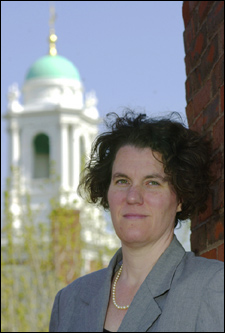College savings plans deceptive
Kennedy Schools Dynarski says plans privilege wealthy savers
Specially designed college savings plans that offer tax-free savings can

actually cost low- and middle-income families more than they save by reducing their eligibility for financial aid, according to a researcher at the John F. Kennedy School of Government.
Susan Dynarski, an assistant professor of public policy, examined the savings incentives created by various savings vehicles, including the Coverdell Education Savings Account (ESA), similar to an IRA for education savings, and the 529 savings plans, which include state and institution-created savings plans to help pay for college tuition.
Dynarski’s findings showed that families sending children to a four-year college could lose as much as $1.22 in need-based financial aid for every dollar they save in a Coverdell ESA, and as much as $1.24 per dollar saved in an account created under the Uniform Transfer to Minors Act. She found that funds held in a 529 plan could lose a family 15 cents of need-based aid for every dollar saved, while a traditional IRA could cost between 26 and 39 cents of financial aid and a mutual fund in a parent’s name would cost 40 cents of financial aid for every dollar saved.
“The financial aid system is designed in such a way that if people put money into the wrong vehicle, they can actually be worse off than if they didn’t save at all,” Dynarski said.
As Dynarski’s articles went to press, the Department of Education announced that it was altering its treatment of the Coverdell ESA. It will now be weighed the same as a 529 in the determination of financial aid eligibility.
Dynarski’s research, currently published in the Kennedy School’s and National Bureau of Economic Research’s working papers series, is slated for publication in two journals, the National Tax Journal and Tax Policy and the Economy.
Dynarski said her research shows that despite political rhetoric when the savings accounts were passed that they would benefit people of modest means, the reality shows that they actually benefit the wealthy, who can reap the tax advantages of the programs but who do not rely on financial aid and thus would not bear the disadvantage of lost financial aid due to savings.
In fact, Dynarski said, her research shows that even if the wealthy use the college savings plans for noncollege expenses, which carries a penalty, they benefit more due to the program’s tax savings than a low-income family who uses the plans for college expenses.
“High-income people gain more from using the Coverdell ESA for noneducational purposes than does a low-income family who uses it to pay for college,” Dynarski said.
For low-income families whose children do not go to college, the penalties for using money in the plans for noneducational uses wipe out what small benefit they may have gained.
Dynarski investigated several different types of savings plans, including traditional IRAs, mutual funds, and the Uniform Transfer to Minors Act account, which is an alternative to a trust account. She investigated the implications of different savings accounts and the impact of these accounts if they’re held in a parent’s or child’s name.
The result, she found, was sharp differences in how families fared from the different savings instruments. She said that college savings plans, now that the treatment of the Coverdell has been corrected, outperform traditional savings accounts. Savings accounts or mutual funds in a child’s name would fare worse than the same account in a parent’s name. The best way to finance college, from a tax standpoint, she said, was through home equity loans, a route that is unavailable to lower-income and many middle-income families who either don’t own homes or for whom repaying the loan would overstretch the family budget.
Dynarski said she’s more interested in effecting policy changes than she is in becoming a financial adviser for families. Dynarski said she isn’t opposed to financial aid being reduced for families that have savings they can use to pay college bills. But she said that tax and financial aid policies should not be drafted in such a way that two families who save the same amount in different savings plans fare very differently when college bills come due.
Her main advice to parents would be to save carefully and to investigate different savings vehicles before putting money into them. And to policy-makers, her message is that saving for college shouldn’t require parents to become financial investigators.
“Financial aid policy has become so complicated that parents pay financial planners to explain it to them,” Dynarski said. “A better-designed aid policy would allow parents to devote their time and money to preparing their children for college rather than to gaming the college financial aid system.”




